Configure Telephony Organizationally Unique Identifiers (OUI) Settings on a Switch
Available Languages
Objective
The Voice Virtual Local Area Network (VLAN) is used when traffic from Voice over Internet Protocol (VoIP) equipment is assigned to a specific VLAN that is made up of voice devices such as IP phones, VoIP endpoints, and voice systems. The switch can automatically detect and add port members to the Voice VLAN, and assign the configured Quality of Service (QoS) to packets from the Voice VLAN. If the voice devices are in different Voice VLANs, IP routers are needed to provide communication.
Organizationally Unique Identifiers (OUI) can add a particular manufacturer Media Access Control (MAC) address to the OUI table. The first three bytes of the MAC address has an identifier of the manufacturer, and the last three bytes contain a unique station ID. Once the OUIs are added to the table, the voice which is received from a specific IP phone on the ports of the voice VLAN ports is forwarded on the voice VLAN provided the particular IP phone is listed in the OUI table.
This article provides instructions on how to configure Telephony OUI settings on a switch.
Applicable Devices
- Sx200 Series
- Sx250 Series
- Sx300 Series
- Sx350 Series
- SG350X Series
- Sx500 Series
- Sx550X Series
Software Version
- 1.4.7.06 — Sx200, Sx300, Sx500
- 2.2.5.68 — Sx250, Sx350, SG350X, Sx550X
Configure Telephony OUI Settings on a Switch
Configure Telephony OUI Settings
Important: Before proceeding with the steps below, make sure that VLANs are configured on the switch. To know how to configure VLAN settings on your switch, click here for instructions.
Step 1. Log in to the web-based utility and choose Advanced from the Display Mode drop-down list.

Note: If you have an Sx300 or Sx500 Series switch, skip to Step 2.
Step 2. Choose VLAN Management >Voice VLAN > Telephone OUI.
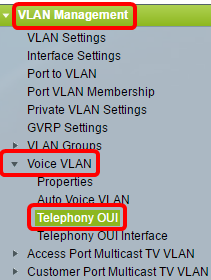
Note: The menu options may vary depending on the switch that you have. In this example, SG350X switch is used.
The Telephony OUI Operation Status area shows whether voice traffic is identified by the OUIs. It is disabled by default. To learn how to configure this feature, click here for instructions.
Step 3. Choose the CoS/802.1p queue to be designated to the voice traffic from the CoS/802.1p drop-down list. A queue is like a buffer that filters the outbound traffic, and holds it until it can leave the switch through an outgoing port.
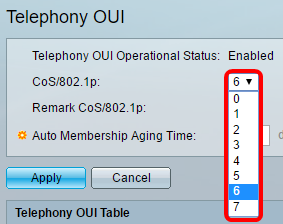
Note: In this example, 6 is chosen.
Step 4. Check the Remark CoS/802.1p check box to remark the egress traffic.

Step 5. In the Auto Membership Aging Time fields, enter the time delay to remove a port from the voice VLAN after all the MAC addresses of the phones which are associated with the ports have timed out. It can be entered in terms of days, hours and minutes.

Note: In this example, the aging time used is 2 days, 12 hours, and 30 minutes.
Step 6. Click Apply to apply the settings.
Step 7. (Optional) Click Save to save the settings to the startup configuration file.
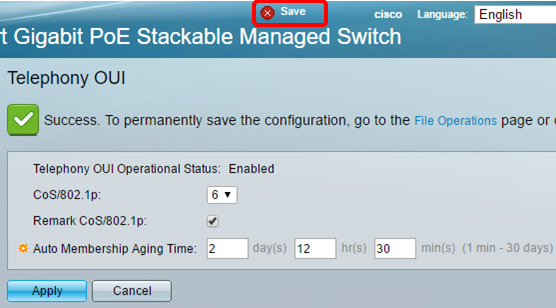
You should now have configured the Telephony OUI settings on your switch.
Configure Telephony OUI Table
The Telephony OUI table displays the following:
- Telephony OUI — Displays the first six digits of the MAC address that is allocated for OUIs.
- Description — Displays the corresponding OUI description.
Step 1. Click Add to add a new OUI.
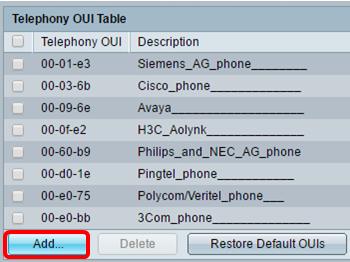
Step 2. Enter the new OUI in the Telephony OUI field. It contains three octets.

Note: In this example, 00-34-ab is used.
Step 3. Enter the OUI Name in the Description field.

Note: In this example, Sample Phone is used.
Step 4. Click Apply then click Close. The Telephony OUI should be added to the Telephony OUI table.

Step 5. (Optional) Click Restore Default OUIs to remove all the user-created OUIs and show only default OUIs in the table.
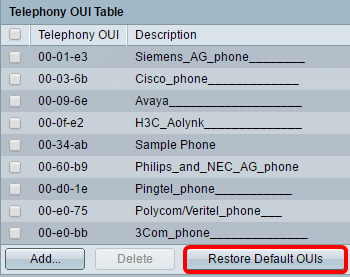
Step 6. (Optional) To delete a particular Telephony OUI, check the check box of the desired OUI then click Delete.
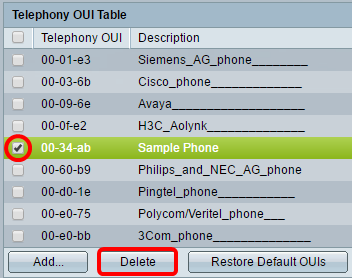
Note: In this example, 00-34-ab is deleted.
Step 7. (Optional) Click Save to save the settings to the startup configuration file.
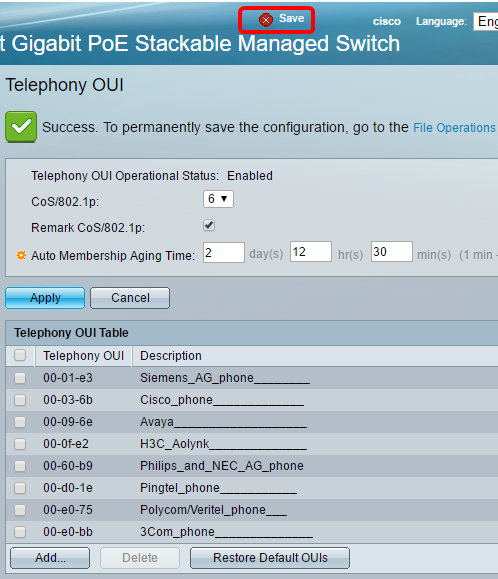
You should now have configured the configured the Telephony OUI Table on your switch.
Revision History
| Revision | Publish Date | Comments |
|---|---|---|
1.0 |
13-Dec-2018 |
Initial Release |
 Feedback
Feedback